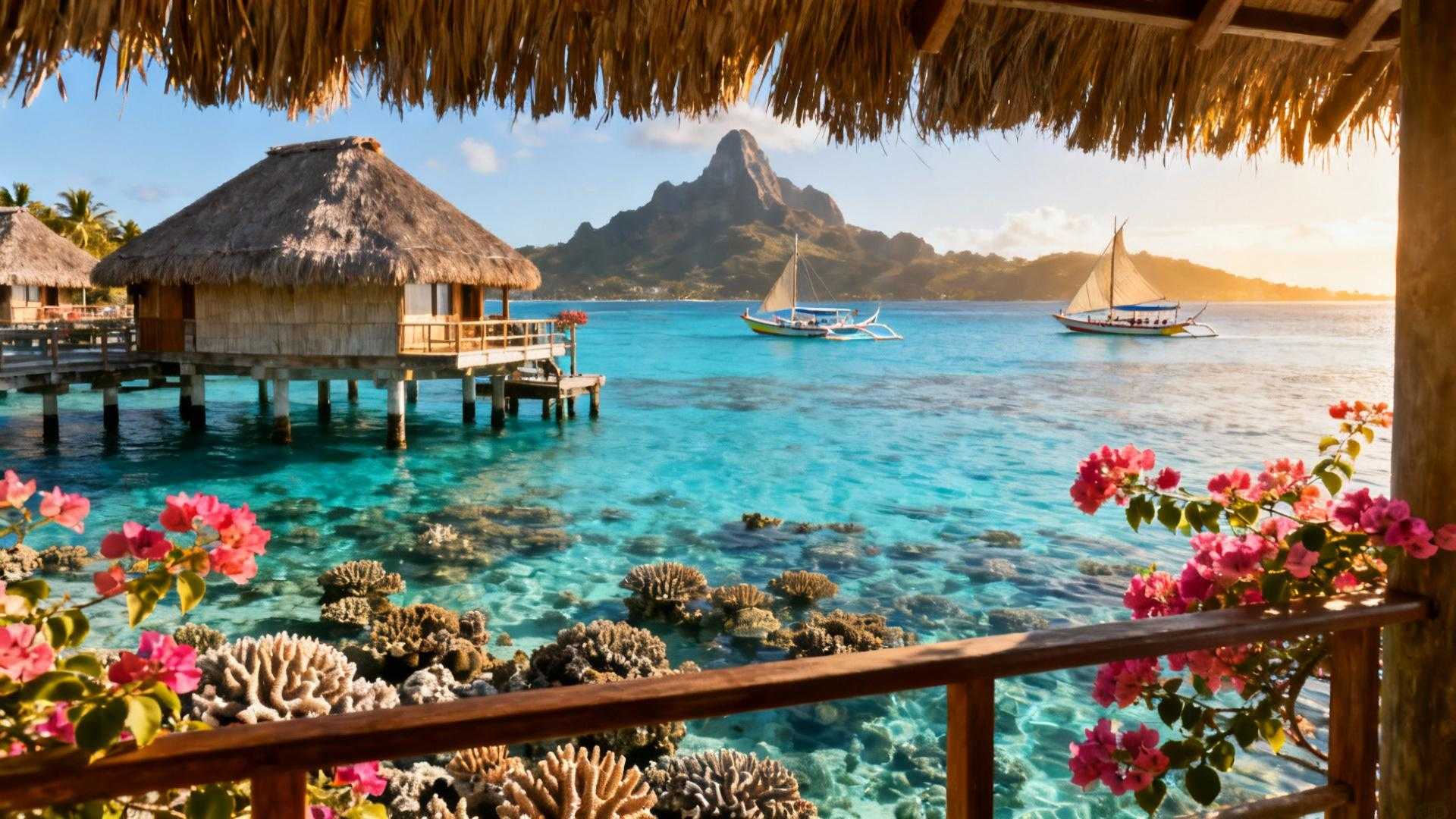At dawn on Motu Tautau, the Pacific Ocean transforms into liquid sapphire. This private islet cradles just 59 overwater suites — the entire resort footprint of Le Taha’a by Pearl Resorts, French Polynesia’s first Relais & Châteaux sanctuary. While Bora Bora drowns in 2 million annual tourists, this 300-meter coral jewel remains what locals protectively call “Vanilla Island’s Private Sister.”
The scale creates instant intimacy. No crowds jostle for sunset photos. No mega-resort sprawl disrupts the horizon. Just you, the sapphire lagoon, and volcanic rock walls concealing private plunge pools where reef fish dart through crystalline shallows.
This is Polynesian luxury as cultural guardians intended — small enough to know every guest’s name, exclusive enough to guarantee sea turtle encounters in private coral gardens steps from your villa. Bora Bora’s commercialized waterfront feels like a distant memory here.
The intimate scale that creates authentic magic
Why 59 suites changes everything about luxury travel
Motu Tautau’s compact footprint forces architectural harmony. The resort wraps around sacred old-growth trees that Polynesian tradition considers protective spirits. Beach Villas open directly onto powder sand, while Overwater Suites extend on wooden piers above coral gardens teeming with parrotfish and spotted rays.
The protected coral sanctuary Bora Bora lost decades ago
Limited guest capacity preserves what mass tourism destroys. The resort’s coral gardens maintain near-pristine health — a stark contrast to Bora Bora’s crowded snorkel zones where guides herd tourists through depleted reefs. Here, marine biologists partner with staff to monitor ecosystem vitality. You’ll snorkel alone at dawn, liquid sapphire light refracting through healthy coral structures.
Unique characteristics that defy typical resort expectations
Relais & Châteaux distinction means authentic Polynesian hospitality
As the only Relais & Châteaux member in Tahiti Islands, Le Taha’a meets rigorous standards for cultural authenticity and environmental stewardship. The lobby resembles a traditional outrigger canoe, two stories of hand-carved wood and woven pandanus leaves. Three restaurants serve vanilla-infused Polynesian cuisine using ingredients from neighboring farms — not imported resort fare.
Architecture that honors ancestral building traditions
Thatched roofs follow centuries-old construction methods. Volcanic rock walls create natural privacy without concrete barriers. The resort commissioned local artisans to carve traditional tikis and weave decorative panels, employing techniques passed through generations. This isn’t resort theater — it’s genuine cultural preservation woven into luxury infrastructure.
Local secrets only island families share
The 35-minute boat transfer reveals insider geography
From Raiatea Airport, the resort’s dedicated shuttle glides past uninhabited motus where frigatebirds nest and black-tipped reef sharks patrol shallows. Guides point out vanilla plantations on Taha’a’s volcanic slopes and pearl farms anchored in protected bays. This journey contextualizes your destination — you’re entering a working island community, not a tourist bubble.
Vanilla Island heritage shapes authentic experiences
Taha’a produces 80% of French Polynesia’s vanilla. Resort excursions visit family-owned plantations where farmers demonstrate hand-pollination techniques refined over generations. You’ll taste fresh vanilla bean directly from cured pods, understanding why Tahitian vanilla commands premium prices. Black pearl farm tours reveal the delicate cultivation process creating Polynesia’s signature gemstones.
The authentic experience tiny places provide naturally
Sustainable practices protect what guests come to experience
Algae-based fertilizers nourish resort gardens. Solar panels supplement energy needs. Staff maintain coral nurseries to regenerate damaged reef sections. The resort caps guest numbers to prevent environmental strain — contrast this with Bora Bora properties cramming 200+ rooms onto similar-sized motus.
Cultural immersion happens organically at small scale
Evening traditional dance performances feature staff members’ family troupes, not hired entertainers. The spa incorporates monoi oil treatments using recipes from local healers. Kitchen staff teach Polynesian cooking techniques in intimate classes where you prepare poisson cru alongside resort chefs. This cultural exchange feels genuine because relationships form naturally when only 59 suites shelter travelers seeking authentic connection.
October brings tail-end dry season perfection — 77°F waters, minimal rain, and post-European-summer tranquility before November’s occasional cyclones arrive. Book six months ahead for May-October prime windows.
Planning your tiny islet sanctuary experience
How do I reach Le Taha’a from major airports?
Fly to Papeete (Tahiti), then domestic Air Tahiti flight to Raiatea Airport (1 hour). Resort boat transfer takes 35 minutes across sapphire lagoon. US travelers connect through Los Angeles; UK/AU through Auckland.
What makes this more authentic than Bora Bora resorts?
Smaller scale enables genuine Polynesian cultural immersion. Staff-to-guest ratios allow personalized service. Protected coral gardens maintain ecosystem health. Local family partnerships create authentic experiences versus commercialized resort activities.
When should I visit for optimal weather and value?
May-October dry season offers perfect conditions. October specifically provides excellent weather with fewer crowds than peak July-August. Book now for 2026 dry season before rates increase.
